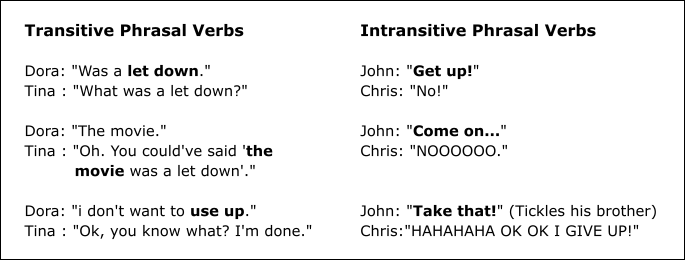Phrasal Verbs: Separable & Transitive
A phrasal verb is a group of words that combines a verb with an adverb, a preposition, or both. Together, these words act as a single verb and it takes on a whole new meaning, which is different or independent from the meaning of the individual constituent words.
For this topic, we will mainly focus on the following subtopics:
- Separable Phrasal Verbs
- Transitive Phrasal Verbs
Separable Phrasal Verbs
Separable Phrasal Verbs are the ones in which the two words can be separated by putting a direct object in the middle.
If the Phrasal Verb is Inseparable, then we will not be able to separate the two words to put the object in between them.
Let us understand it better through a few examples:
Separable Phrasal Verb example - TURN OFF. It can be used in different ways like:
- Please turn off the TV.
In this example, the TV is the direct object, and turn off is the separable phrasal verb.
- Please turn the TV off.
In this example, the direct object of the TV has been put in between the two words of separable phrasal verb turn off. The sentence thus formed is still grammatically correct.
Let us compare it with an example of an Inseparable Phrasal Verb.
Inseparable Phrasal Verb example - LOOK AFTER. Consider the following usage of this phrasal verb:
- I will look after your dog while you are on vacation.
Here look after is the inseparable phrasal verb and your dog is the direct object.
- I will look your dog after while you are on vacation. (INCORRECT)
In this usage, we have tried to separate the phrasal verb look after by putting the object your dog in between. However, this makes the sentence grammatically INCORRECT.
Thus, we see that we cannot separate the two words in Inseparable Phrasal Verbs.
Question 1:
Is the phrasal verb “go away” separable or inseparable?
- Separable
- Inseparable
- Neither
- Both
Solution:
(1) Separable
Examples of Separable and Inseparable Phrasal Verbs
- Separable Phrasal Verb - cut off
- Don’t cut me off.
- I was cut off from them.
- Inseparable Phrasal Verb - go away
- Don’t go you away. (INCORRECT)
- You will go away. (CORRECT)
- Phrasal Verb - take up
Some phrasal verbs have multiple meanings depending on their usage. They can be used both as separable as well as inseparable phrasal verbs.
- One meaning of take up is ‘to start’ as in a new hobby/sport/activity. For example:
- I want to take up badminton to keep myself fit.
- Another meaning of take up is ‘to occupy’ time/space/attention. For example:
- Can you please take this matter up with the principal?
Here, it means bringing to the attention of the principal. It is used as a separable phrasal verb.
- Can you please shift that box? It takes up too much space.
Here, it means that the box is occupying too much space. It is used as an inseparable phrasal verb.
- Another meaning of take up is to accept an offer. For example:
- I will take you up on your offer.
Here it is used as a separable phrasal verb.
Question 2:
“------- her --------, Carl! She is spewing up mud!!!” the exasperated farmer called to his assistant as the new pump they were testing started to malfunction.
- Turn --- down
- Shut --- off
- Tear --- up
- Figure --- out
Solution:
(2) Shut --- off
Question 3:
“__________ it __________, Carl! The neighbours can hear it!!!” The exasperated farmer called to his assistant as the new pump they were testing started to clank and crash loudly.
- Turn --- down
- Shut --- off
- Tear --- up
- Figure --- out
Solution:
(1) Turn --- down
Transitive Phrasal Verbs
Phrasal verbs are verbs made up of two or three words: Main verb + particle (preposition or adverb)

Transitive phrasal verbs need something (an object) after them. In a transitive phrasal verb, it is possible to put the object between the verb and the adverb/preposition, or it can be put afterwards. There is no difference in its meaning.
When the object is put in between the verb and the adverb/preposition, then it is called a Separable Phrasal Verb. For example: Turn the TV off.
When the object puts the verb and adverb/preposition, then it is called an Inseparable Phrasal Verb.
For example:
Intransitive Phrasal Verbs mean that they have no direct object. That means that there is no word in the sentence that tells who or what received the action of the verb. Some examples are -
- I get up at 6 am.
- He stepped aside for the bicyclist.
- You can come over to my house after school

Thus, from this, we can see that Intransitive Phrasal verbs can stand by themselves. They do not need any object to make the sentence complete. But Transitive Phrasal verbs cannot sit by themselves. They need an object to act upon.
Dora should have said: The movie was a letdown.
And …
I don’t want to use up my energy.
Some more examples:
- Call for help / backup / someone
- Hold back tears/anger
- Pay off debts / hard work
Question 4:
“__________ this portion of the receipt and submit it to take part in the lucky draw.”
- Use up
- Tear on
- Shoot up
- Tear off
Solution:
(4) Tear off
Question 5:
The phrasal verb ‘wind up’ can be used separated and un-separated. Is this True or False?
Solution:
True
Conclusion
In this article, we learnt about phrasal verbs and their different types.
Phrasal verbs can be categorized into two main types:
- Transitive Phrasal Verbs
This type of phrasal verb needs some object to act upon.
- Separable Phrasal Verbs
The direct object can be inserted in between the verb and the adverb/preposition.
- Inseparable Phrasal verbs
The direct object cannot be inserted in between the verb and the adverb/preposition. The phrasal word cannot be separated.
- Intransitive Phrasal Verbs
These phrasal verbs can sit by themselves and do not need an object to complete the sentence.
Test Your Concepts
Question 1:
Take 5 phrasal verbs and try them out in sentences. Categorize them into separable and inseparable phrasal verbs.
Solution:
Let us see the following phrasal verbs.
- get on
Get him on the bus. (separable)
- fly off
Please fly the VIP off tomorrow. (separable)
- run into
I ran into my friend at the bookstore. (inseparable)
- run across
Please run this across the wall. (separable)
- take on
I will take him on. (separable)
Question 2:
A separable phrasal verb is a kind of transitive phrasal verb. True or False?
Question 3:
An inseparable phrasal verb is ALWAYS a kind of transitive phrasal verb. Is this True or False?
 SG
SG  VN
VN 












